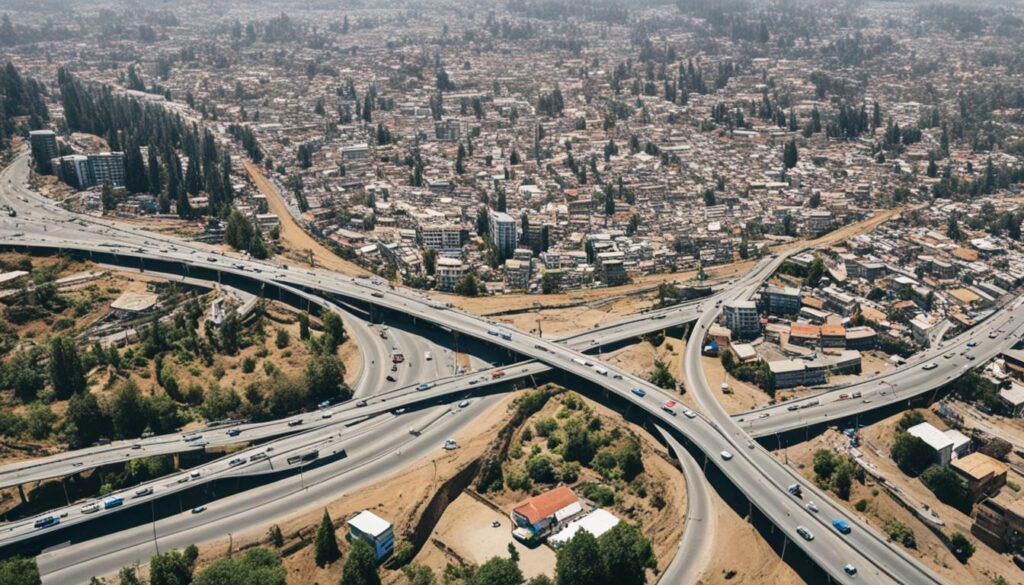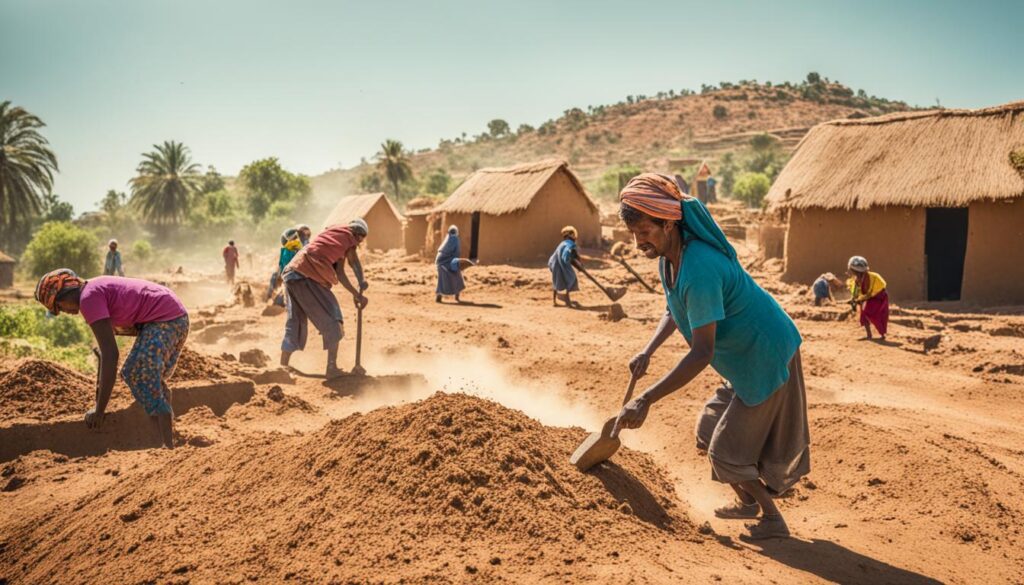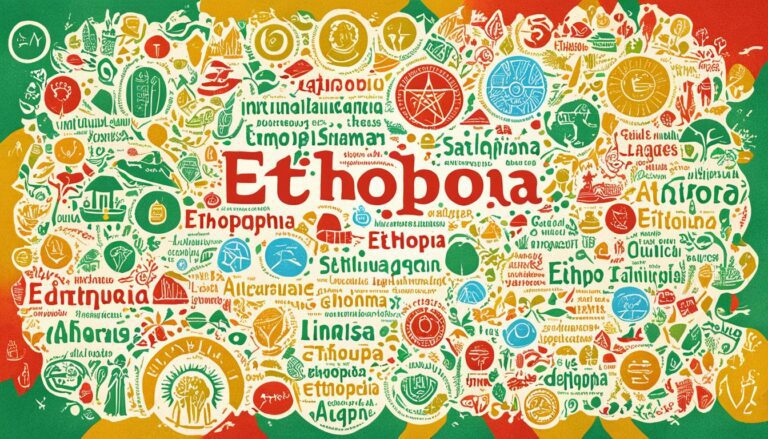Is Ethiopia a Third World Country?
Did you know that Ethiopia is classified as a Least Developed Country (LDC)? According to the latest data from the triennial review, Ethiopia was included in the LDC category in 1971. This surprising fact sheds light on the country’s development status and raises questions about its global ranking.
When it comes to measuring development, key indicators such as Gross National Income (GNI) per capita and the Human Assets Index (HAI) play a significant role. In Ethiopia, the GNI per capita is $832, which falls below the inclusion threshold of $1,018. The country also has a HAI of 55.3, below the inclusion threshold of 60. These figures reflect the economic and human development status of Ethiopia.
Key Takeaways:
- Ethiopia is classified as a Least Developed Country.
- The country’s Gross National Income (GNI) per capita is below the inclusion threshold.
- Ethiopia has a Human Assets Index (HAI) below the inclusion threshold.
- These indicators reflect the country’s economic and human development status.
Ethiopia’s Economic Classification and Poverty Level
Ethiopia, one of the least developed countries worldwide, has an economy heavily reliant on agriculture, which contributes to 36% of its GDP.
“Agriculture is the backbone of our economy,” says Abebe Selassie, the director of the African Department at the International Monetary Fund.
“Our farmers play a vital role in sustaining our nation, but we still face significant challenges in diversifying our economy.”
In this predominantly agrarian society, poverty remains a pervasive issue, with a significant portion of the population living below the poverty line.
“We recognize the urgent need to address poverty and create opportunities for our people,” affirms Teshome Toga, Ethiopia’s Minister of Finance.
The World Bank estimated that in 2019, around 23% of Ethiopians were living in extreme poverty, struggling to meet their daily basic needs.
Table: Ethiopia’s Poverty Statistics
| Year | Percentage of Population Living in Extreme Poverty |
|---|---|
| 2015 | 29% |
| 2016 | 25% |
| 2017 | 24% |
| 2018 | 25% |
| 2019 | 23% |
This table showcases the poverty level in Ethiopia over the past five years, demonstrating a gradual decline but still highlighting the pressing nature of poverty alleviation efforts.
Eradicating poverty and fostering inclusive economic growth are critical priorities for Ethiopia’s future development.
Ethiopia’s Infrastructure Quality and Human Development Index

Ethiopia’s development is intricately tied to the quality of its infrastructure. Significant investments have been made in the transportation and energy sectors, with the aim of improving the country’s overall infrastructure. However, despite these efforts, there remain challenges in providing reliable and efficient infrastructure services to all parts of Ethiopia.
The Human Development Index (HDI) is another important indicator of Ethiopia’s development status. With a score of 0.498, Ethiopia is classified as a low-human development country. This means that there is significant room for improvement in various aspects of human development, including education, healthcare, and overall living standards.
Improving infrastructure quality is crucial for Ethiopia’s continued development. It plays a vital role in attracting investments, fostering economic growth, and enhancing the overall well-being of the population. By investing in and upgrading infrastructure, Ethiopia can create opportunities for businesses, improve access to basic services, and promote sustainable development.
“Investing in infrastructure is investing in the future of Ethiopia. It paves the way for economic growth, enhances connectivity, and improves the quality of life for all Ethiopians,” says Alemayehu, an infrastructure expert.
Challenges and Opportunities
Despite ongoing efforts, Ethiopia still faces challenges in infrastructure development. The country’s vast size and diverse geography present logistical difficulties in delivering services to remote areas. Additionally, the maintenance and sustainability of existing infrastructure pose ongoing challenges.
However, Ethiopia also has considerable opportunities for infrastructure development. With a growing population and increasing urbanization, there is a growing demand for improved transportation networks, energy systems, and telecommunications infrastructure. By harnessing these opportunities and implementing innovative solutions, Ethiopia can make significant strides towards improving infrastructure quality and overall development.
The Importance of Sustainable Infrastructure
“Sustainable infrastructure is not just about constructing buildings and roads. It’s about designing and implementing solutions that are environmentally friendly, resilient, and can withstand future challenges,”
states Amina, an environmental advocate.
Sustainable infrastructure development is essential for Ethiopia’s long-term growth and resilience. By incorporating renewable energy sources, promoting efficient waste management systems, and adopting climate-smart design practices, Ethiopia can mitigate the environmental impact of infrastructure development and ensure a sustainable future for generations to come.
Ethiopia’s Living Standards and Social Progress

The living standards in Ethiopia vary widely across different regions and communities. While progress has been made in certain areas, access to basic services such as healthcare, education, clean water, and sanitation remains limited, particularly in rural areas. This disparity contributes to the challenges faced by the country in improving overall living conditions.
Efforts have been made to address these issues and promote social progress in Ethiopia. Poverty reduction programs have been implemented to lift vulnerable populations out of extreme poverty and provide them with opportunities for a better life.
“Our focus is on creating a more inclusive and prosperous society for all Ethiopians,” says Amina Mohammed, Deputy Secretary-General of the United Nations. “Through targeted initiatives, we aim to improve access to education, healthcare, and clean water, helping to uplift the living standards of the Ethiopian people.”
The government has prioritized increasing access to education, recognizing it as a crucial driver of social and economic development. Efforts to improve the quality of education and expand educational opportunities, including vocational training, aim to equip the population with the skills needed for sustainable livelihoods.
Improving healthcare services is also a key focus in Ethiopia’s pursuit of social progress. Initiatives such as the Health Extension Program, which brings basic healthcare services closer to communities, have been implemented to address some of the challenges in delivering healthcare to remote areas.
“Investing in healthcare and education is investing in the future of our nation,” says Dr. Tedros Adhanom Ghebreyesus, Director-General of the World Health Organization. “By prioritizing these sectors, we can make significant strides towards improving the living standards and well-being of all Ethiopians.”
Despite these efforts, there is still a long way to go in achieving sustainable development and improving living standards for all Ethiopians. Continued investments and collaborative efforts from government, non-governmental organizations, and international partners are crucial in addressing the existing challenges and creating lasting positive change.
Conclusion
Ethiopia’s classification as a Least Developed Country reflects its current development status. The country faces significant challenges in various aspects, including poverty, infrastructure quality, and social progress. However, Ethiopia has shown determination in improving its development indicators and has demonstrated promising growth in sectors such as agriculture and manufacturing.
Continued investments in infrastructure, education, healthcare, and poverty reduction programs are crucial for further advancing Ethiopia’s development and enhancing the living standards of its people. By focusing on these key areas, Ethiopia can create opportunities for economic growth, enhance access to essential services, and uplift its population out of poverty.
While progress has been made, it is essential to establish sustainable strategies that address the root causes of Ethiopia’s development challenges. To achieve long-term, inclusive growth, collaboration between the government, international partners, and civil society organizations is crucial. By working together, we can support Ethiopia in overcoming its current obstacles and fostering a brighter future for all Ethiopians.






